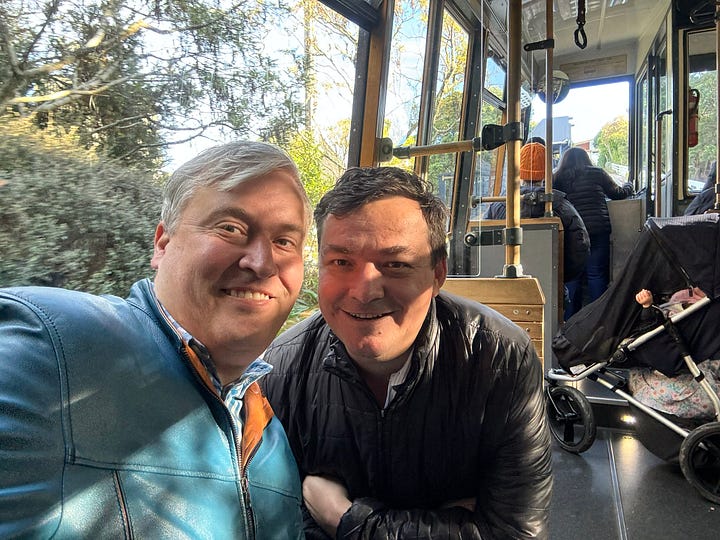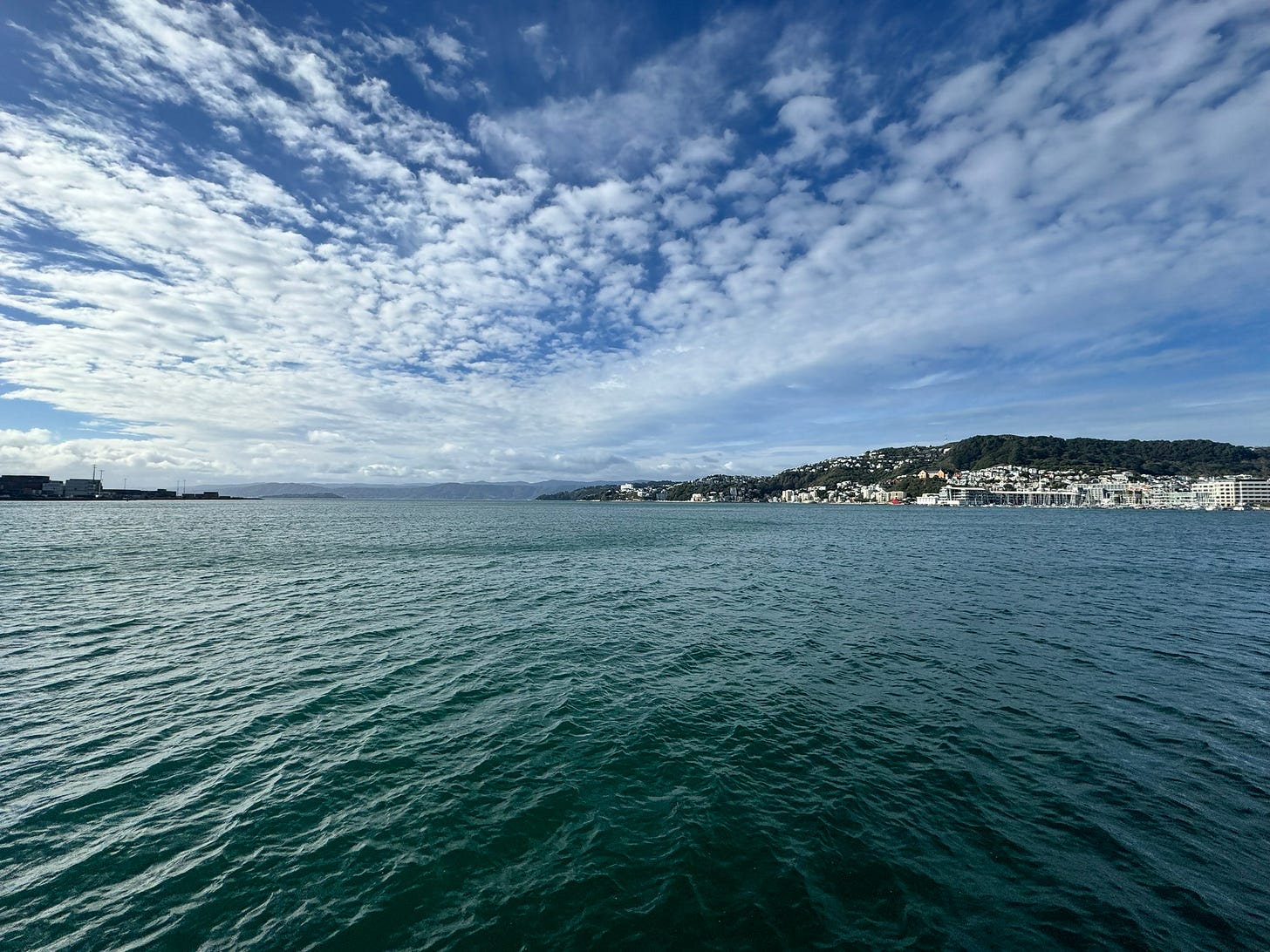Last June, Tibi and I traveled to Australia for some work meetings and decided to make the most of this trip halfway around the world by tacking on a vacation to New Zealand. We had never been before, and, although it seems to be a country on the top of many folks’ bucket lists, it had never ranked that highly on ours. We have seen all the Lord of the Rings films, and the scenery looked stunning, to be sure, but we had always been lured more strongly by the siren songs of other locales.
In December 2023, however, the New York Times published its annual list of the “52 Places to Go in 2024.” Number 4 on the list was New Zealand. But not just New Zealand…the list featured a new tourist train line that spans the entire length of the north and south islands. The article described “riding the rails through vineyards, volcanoes, and snow-capped peaks.” The train cars are equipped with partial glass ceilings and huge windows that provide panoramic views, as well as an open-air car to see the landscape unimpeded. It sounded spectacular.
And so we booked our flights to New Zealand and, along with it, two train tickets from Wellington to Auckland—across the entire length of the north island.
We arrived to Wellington on a Friday morning, with plans to stay there until Sunday, when we would start our train ride north. Wellington was an interesting, small city, built on hills surrounding a central harbor. It is a bit like San Francisco, but with less beautiful architecture. But it does have some nice restaurants and a few sights worth visiting.
One phenomenon that struck me almost immediately upon arrival was the ubiquity of the Māori language. As a US American, I’m so accustomed to Indigenous culture being silence and outright destroyed. Indigenous languages are everywhere in the US in the names of places and landmarks—from the Mississippi River to my home island of Manhattan to my former high school in Georgia, Chattahoochee. Despite the presence of these words, however, the stories, cultures, and traditions behind them are totally obscured. Most cannot even identify which of the hundreds of Indigenous languages each of these names comes from.
New Zealand is remarkably different. From the moment of landing, we were welcomed not just to New Zeland, but also to Aotearoa, the Māori name for the islands. Street signs and buildings often featured Māori, with the Māori translations frequently preceding the English. And nearly everyone in the country, Māori or no, saluted us with a generous “Kia ora!,” the Māori greeting that literally translates to “Have life” or “Be healthy.” Some of the demographic particulars of New Zealand have likely facilitated the pervasiveness of the Indigenous language throughout the country compared to the US. For example, around 20% of the country’s population is Indigenous, comparted to just over 1% of the population in the US. Likewise, the Indigenous peoples of New Zealand share a single language, while over 160 are currently spoken in the US. (It used to be many more before, you know, genocide rendered many of them extinct.) Whatever the reason, I found this omnipresence of Māori at once fascinating and inspiring. As a scholar and practitioner in the arts of dealing with difficult pasts, the foregrounding of Māori langauge and culture felt reparative and important—something that extended beyond the simple land acknowledgments we are starting to make in the United States. There is certainly more work to be done, as a recent demonstration by Māori legislators over a new law reinterpreting a historic treaty between the Māori and the colonizers demonstrates, but all in all it puts the US to shame.
This deep dive into Māori culture continued at the Te Papa Tongarewa, the Museum of New Zealand. This lage museum on Wellington Harbor explores numerous aspects of life in New Zeland, including its history, flora and fauna, and the imprint of phenomena like earthquakes. (It features a model home that actually shakes to demonstrate what an earthquake feels like.) But a big section of the museum explains aspects of Māori culture. There is a gorgeous wooden ceremonial building, along with several hand-carved boats. Most fascinating for me was an interactive display explaning how the Māori and other Polynesian peoples used the starts to navigate the seas. The very idea of people setting sail into a vast, unknown ocean and traveling thousands of miles in seach of land is incredible and terrifying. But what is truly mindblowing is that they were then able to communicate to others the exact location of the new land they found. I honestly cannot wrap my mind around it.
While all these experiences offered ample opportunities to engage with Kiwi culture, one unexpected reality was that dining out was often not such an opportunity. At almost every restaurant we visited during our stay in the country, our servers came from everywhere in the world except New Zealand. All of them were taking advantage of a unique program called a working holiday visa. This visa program allows travelers—mostly young people—to come to New Zealand for one year, working in jobs that are otherwise difficult to fill. Most, it seems, are in the service industry. Young Europeans in particular seemed to be taking advantage of the program.
Our first meal in Wellington, for example, was at Ortega Fish Shack. Don’t be fooled by the name; this restaurant was far from a shack. In fact, it was quite refined in that old-school way, with smartly dressed waiters and bistro-style seating. Our waitress was a young, congenial, blonde woman from Edinburgh who had just recently landed in Wellington. She planned to start working there for a few months, then travel to other parts of the country with her boyfriend. We had a delicious meal at the “fish shack” that included fresh seafood and a sauvignon blanc so grassy it felt like we’d just mowed our lawn—all this interspersed with friendly conversation with our lovely server. We almost lost her affection when we ordered Irish whiskey, rather than Scotch, to end the meal. But she said she forgave us when she asked if we wanted it on the rocks and we looked at her with horror, saying, “Absolutely not.”
The next night we had another fantastic meal at a wine bar called Noble Rot. This place was funky and modern, with a rustic wood and industrial metal interior. We had bright, briny oysters to start, and the owner/sommelier, who was originally from Poland, was thrilled when we asked him for a recommendation for a surprising wine that would make us think differently about wines from New Zealand. He brought us a mindblowing nebbiolo from a small producer called Hans Herzog that had us captivated throughout the entirety of the bottle. This was the moment we realized New Zealand had much more to offer than sauvignon blancs—a fact that we would verify again and again throughout our trip. This special wine capped off an already fantastic dinner—one of the best we would have in the country.
Earlier that day, we’d had the opportunity to explore Wellington a bit more. We took the century-old cable car—more funicular than San Francisco trolley—up the steep hillside to the Wellington Botanic Garden, which we walked around to explore the local flora. Ever since buying our house in upstate New York, I have become increasingly obsessed with birdwatching, which has been facilitated by an incredible app put out by Cornell University’s ornithology lab called Merlin. It’s basically Shazam for birds. When you hear birdsong, you can press a button in the app, and Merlin tells you which bird it is. It works flawlessly in the US, but a little less so abroad. No matter, because it also includes a feature to identify birds by sight. You can tell the app the relative size of the bird, its colors, and where you saw it, and it spits out a list of possible matches. Tibi and I had a blast seeking out these previously unknown birds as we walked through the gardens.




But perhaps our favorite moment in Wellington came when we went for a predinner drink to The Library, a hip bar that coyly walks the line between divey and chic. Wooden shelves with antique volumes line the walls, and all the specialty cocktails take their inspiration from literature. When we were seated at our table, the server handed us the official menu, along with a separate menu for that night only. They were celebrating the last shift of their colleague, Bella, and this menu included all of Bella’s favorite drinks. The names of the drinks were all variations on a theme. There was an elegant take on a gimlet called “Fancy as F*ck” and a booze-filled party drinked called “Drunk as F*ck.” But there was also Bella’s favorite sav blanc, which you could order in one of two sizes: a “normal pour” or a “Bella pour.” Since then, when one of us is pouring a glass of wine for the other, Tibi or I will frequently say, “Give me a Bella pour.” And in this way our trip to Wellington lives on.
Stay tuned for Part Two of the New Zealand trip…






